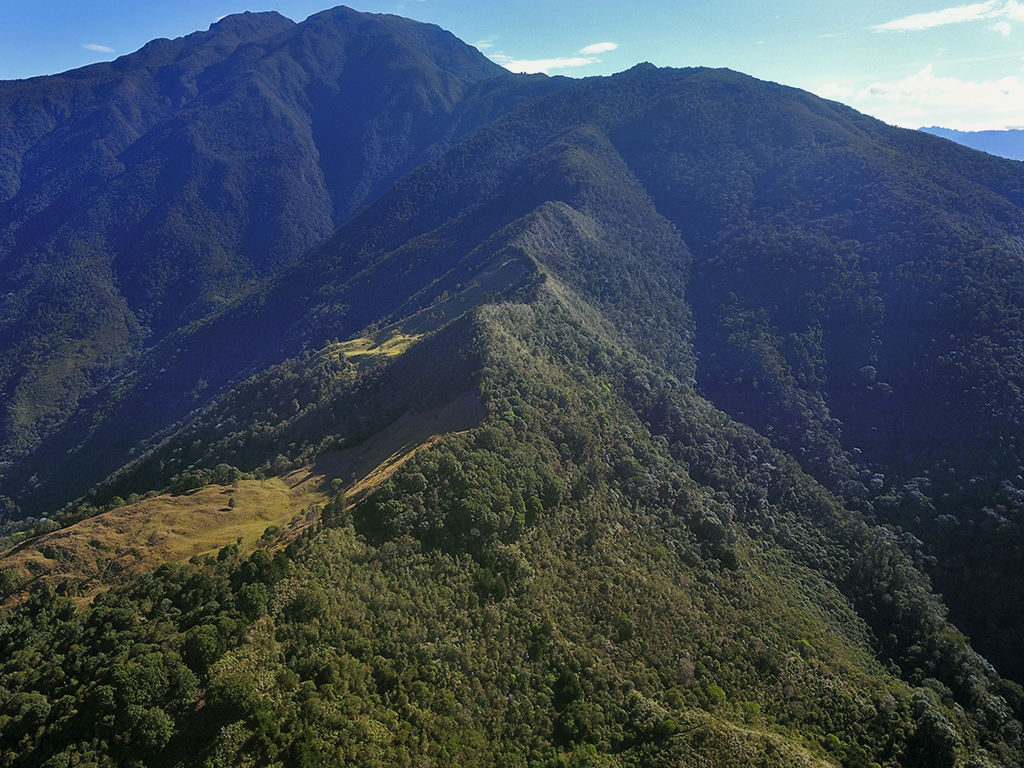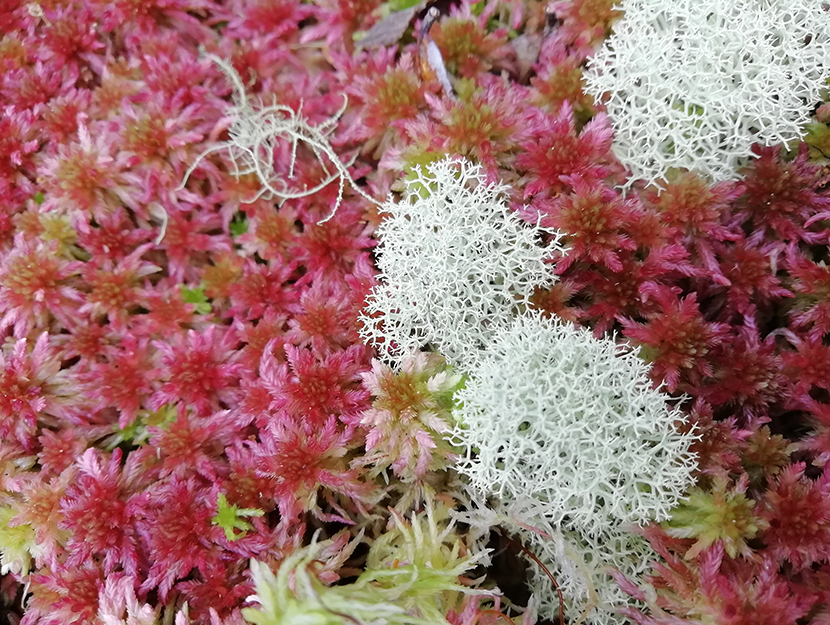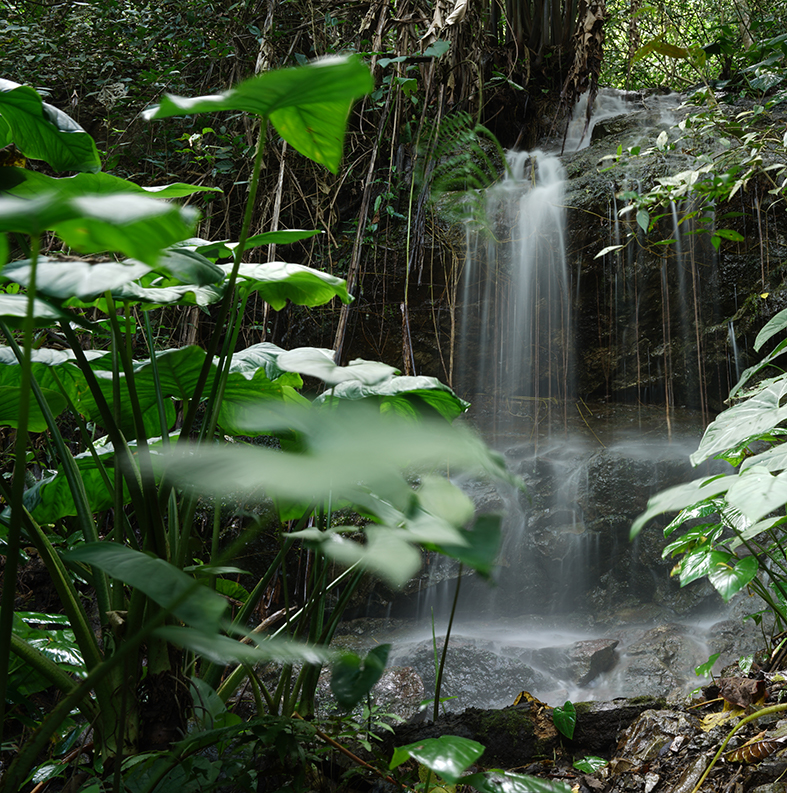Sub-Andean Forest
In the sub-Andean strip, elements of the dry forest converge with species typical of this strip, which is characterized by higher levels of humidity and, therefore, tends to be more diverse, but just as threatened as the dry forest.
Normally located above 1,000 meters above sea level, and depending on the area up to about 2,000 or higher, around 2,400 meters. This strip corresponds to the coffee-growing zone and large areas that have been transformed into pastures, cultivated areas and villages, and is therefore a strip in constant transformation and deterioration.
In the reserve, the sub-Andean strip is mainly occupied by natural regeneration that is about 40 years old, small fragments that were heavily disturbed and then surrounded by regeneration and reconnected with the upper part, and riparian strips that have been recovering in terms of both structure and composition. Today they are the preferred habitat of the guacharaca (Ortalis columbiana). Here there is an abundance of intermediate pioneers such as the white balsos (Heliocarpus americanus), the balso tambor (Ochroma lagopus), guamos (Inga spp.) and a very high diversity of laurels and aguacatillos (Ocotea, Aniba, Beilschmiedia, Persea, Nectandra), among which the arenillo (Ocotea wittei), one of the finest woods of this intermediate strip, stands out.

This strip plays a very important role, since it facilitates the flow of species from below to above and vice versa, in search of resources. The natural processes here are faster than in the highlands, therefore, the regeneration of the species is faster because they have higher rates of development, likewise, the food supply is usually more abundant, since numerous species of intermediate pioneers offer food almost constantly. Their regulatory role is also key, in addition to the fact that they are highly diverse.
Andean Forest
In the Andean forest, stratification within the forest is much more complex; epiphytes tend to be one of the groups of greatest interest. These are represented by orchids, bromeliads, anthuriums, ferns and other less abundant species. Non-vascular epiphytes such as mosses and liverworts usually cover a good part of the branches and stems, and even the leaves, in places where humidity is higher, being important regulators of water in forests.
The diversity of plants is very high; among the trees, species such as the oak stand out, which can extend from the sub-Andean, or be located only in the upper part due to the elimination of the lower populations. Trees such as black cedars (Juglans neotropica), pink cedars (Cedrela montana), carisecos (Billia rosea), yolombo (Panopsis spp.), laurels (Ocotea, Nectandra), aguacatillos (Persea, Beilschmiedia), cominos (Aniba perutilis, Aniba spp.), wax palms (Ceroxylon spp.), and many other timber species are found in this strip, which historically has been heavily deforested for cattle ranching.

Plant densities within the forest are high,
and when the forests are in a good state of conservation there is abundant regeneration of canopy species.
Anthuriums (Anthurium spp.) are abundant growing in the understory or as epiphytes or hemiepiphytes at the base of trees. Water is abundant, and the gullies and riparian strips are usually very rich in shrubs and grasses, as well as bryophytes (mosses) that cover the rocks and trunks. These forests are very rich in fauna, as their diversity of species is also rich in fauna resources.
This is the most deteriorated strip within Madhú, since there is only a connection through an oak grove in the upper part; the other areas, which used to be pastures, are currently undergoing succession processes that allow for the reestablishment of an insipient connection, which is improving with time.
High Andean Forest
As you go up above sea level, you experience a decrease in temperature, and the vegetation begins to change. Above 2,800 meters the plants become lower, the large trees that were found in the Andean forest, which can reach up to 40 meters, in the high Andean strip do not exceed 15-20 meters, in the best of cases. The vegetation becomes denser, thinner and the stems twisted, and mosses begin to abound, both on the stems and on the ground, cushions of sometimes multicolored mosses such as those of the genus Sphagnum begin to appear.
If in the Andean forest fog is a key component in water dynamics, in the High Andean forest it is fundamental.
These forests are covered with fog most of the day, sometimes visibility is reduced to a couple of meters and the humidity in the atmosphere is very high. The plants of the high Andean forests have adapted to these conditions, and in order not to lose so much water through radiation, they have become hard, leathery, have developed, as in the páramo, covered with hairs and scales, and the margins of the leaves have curved inwards, while the size of the leaves has been reduced.

Epiphytes are concentrated at the base of trees, and many of them are capable of living on the ground on thick layers of leaf litter. Bromeliads are one such group of epiphytes.
Among the trees, the most outstanding are the encenillos (Weinmannia spp.), the chagualos or raques (Clusia spp.), the sietecueros (Tibouchina lepidota, Tibouchina grossa), hardy laurels such as the black laurel (Ocotea heterochroma), Colombian pine or rosemary on the edges (Podocarpus oleifolius), white aguacatillo (Persea mutisii), nigüitos (Miconia spp.), scandent shrubs or hemiepiphytes such as mortiños (Cavendishia, Psammisia, Thibaudia), canelo de páramo in the lower parts (Drimys granatensis), among many others.

As one ascends, the forest begins to become lower, and only outside the edges and exposed sites, the forest retains trees, which in some cases, when protected from the winds, can reach more than 15 meters in height and high diversities. In the ridge the trees disappear, only a few manage to stay, and there begins to be a change not so noticeable, it is a slow change, in a transition to colder ecosystems and conditions, stronger and icy winds, lots of fog, but little rain. Shrubs then replace the forest, some reaching 3-4 meters, with mosses only at the base, as well as large ear-shaped lichens or raised saplings forming tiny greenish forests.
